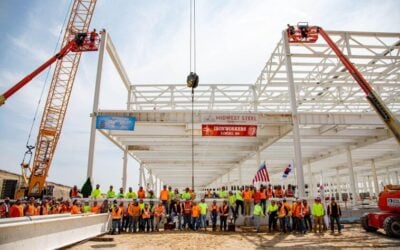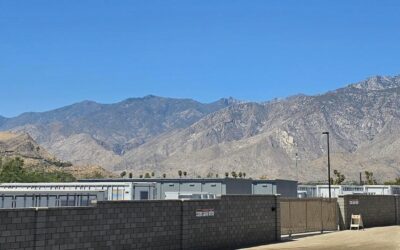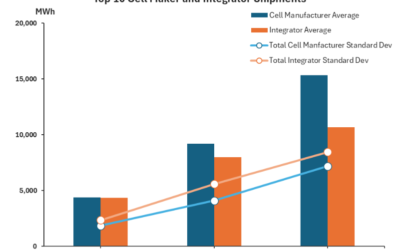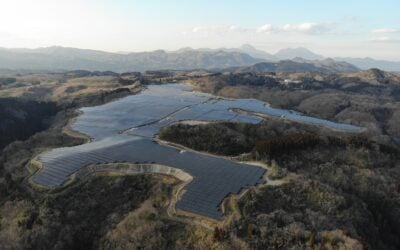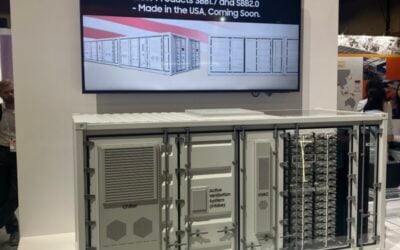Tesla Powerpacks, installed on the American Samoan island of Ta’u by Tesla-SolarCity. Image: SolarCity.
The merging of Tesla and SolarCity into a single entity creates a new company well-placed to deliver a full range of energy-related products and services to consumers, analysts have said.
Shareholders of the two companies, which have already worked together on delivering stationary storage projects for utilities and businesses, voted to merge last Thursday in what is being described as a buyout of SolarCity by the again-profitable EV maker/storage manufacturer.
The US$2.6 billion deal was first announced in July and was described as a key part of Tesla founder and CEO Elon Musk’s “Master Plan: Part Deux” to “accelerate the advent of sustainable energy”. The pair jointly launched a solar roof tile product in October along with the second generation Powerwall and Powerpack battery storage systems.
In the months ahead of the vote, Bloomberg New Energy Finance (BNEF) analyst Logan Goldie-Scot told Energy-Storage.News that a combined company would exploit the synergies between the two, GTM analyst Ravi Manghani said it would lower pressure on SolarCity to achieve profitability and Lux Research’s Cosmin Laslau told the site the match made sense but could potentially distract each from their core objectives. More recently, Julian Jansen of Delta EE said the merged entity could become the “Uber or AirBnB of energy”, in being a service provider without centralised assets.
Try Premium for just $1
- Full premium access for the first month at only $1
- Converts to an annual rate after 30 days unless cancelled
- Cancel anytime during the trial period
Premium Benefits
- Expert industry analysis and interviews
- Digital access to PV Tech Power journal
- Exclusive event discounts
Or get the full Premium subscription right away
Or continue reading this article for free
Post-vote reactions
Emailing their post-vote reactions, Lux Research’s Tyler Ogden and Sam Wilkinson of IHS both appeared to see the combined company moving forward in a strong position.
Wilkinson said that while he was not prepared to comment on the financials of the deal, he said that the growing convergence between the fields of self-consumed solar, stationary energy storage and electric transport operating in an integrated way is becoming apparent.
“The combination of Tesla and SolarCity brings about the first company with a strong presence in all three of these sectors, which places it in a very powerful position for the future,” Wilkinson said.
“It is likely that in the future we will see integrated packages of a car, PV system and home storage that work together in an intelligent way to serve both customers and potentially the grid too. Tesla is now uniquely positioned to be at the forefront of that.”
While rivals in each of those three fields were likely to also partner up to compete with the Tesla-SolarCity beast, the two California companies merged represented a unique single entity, Wilkinson said. In response to speculation that SolarCity might want to use the merger as a platform to expand overseas from its North American base, Wilkinson said it was likely, but in the near future the solar installer would most probably focus on integrating seamlessly with Tesla in its existing markets.
“Tesla’s global brand and operations will certainly be an enabler for this, although it will clearly prioritise markets where a residential solar market is strong.”
Lux Research’s Tyler Ogden similarly said that the merger created “one of the first true new energy companies – a company that has all the pieces to supply a total energy solution to its customers”.
Ogden said that, now faced with the challenge of making money selling to each company’s customer base, Tesla was likely to follow the trend of using solar energy’s ability to lower consumer energy bills as a tactic. For example, “the potential for batteries to be integrated with photovoltaics to provide power services, save additional money under time-of-use rates, or be used by the grid themselves for a price”, Ogden said.
According to Tyler Ogden, Tesla Energy will next be working with utilities in select regions to demonstrate its potential, and as well as home storage and solar would be looking to further its work with utility-scale efforts. One such project was revealed this week, a joint SolarCity-Tesla solar-plus-storage installation on the American Samoan island of Ta’u. Another is the dispatchable 52MWh storage/13MW solar project in Hawaii that the pair completed this year.
Ogden also speculated that as well as stationary storage for the grid, Tesla Energy will start to demonstrate that its EVs’ batteries could be additional power assets. While vehicle-to-grid is still a technology in its early stages of commercialisation, with a handful of pilot projects deployed, Ogden said Tesla Energy will be well placed to execute.
“Tesla has demonstrated its savvy in driving infrastructure through the build-out of its national supercharger networks,” Ogden said.
However the analyst sounded a final cautionary note.
“These paths forward highlight the new company’s potential, but its execution will need to be concentrated and not tackle all our energy needs at once.”
Image: SolarCity.

